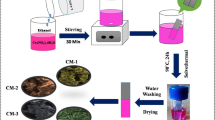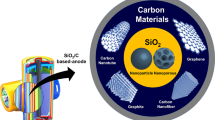Abstract
The bind-free carbon cloth-supported electrodes hold the promises for high-performance electrochemical capacitors with high specific capacitance and good cyclic stability. Considering the close connection between their performance and the amount of carbon material loaded on the electrodes, in this work, NiCo2O4 nanowires were firstly grown on the substrate of active carbon cloth to provide the necessary surface area in the longitudinal direction. Then, the quinone-rich nitrogen-doped carbon shell structure was formed around NiCo2O4 nanowires, and the obtained composite was used as electrode for electric double layer capacitor. The results showed that the composite electrode displayed an area-specific capacitance of 1794 mF·cm−2 at the current density of 1 mA·cm−2. The assembled symmetric electric double layer capacitor achieved a high energy density of 6.55 mW·h·cm−3 at a power density of 180 mW·cm−3. The assembled symmetric capacitor exhibited a capacitance retention of 88.96% after 10000 charge/discharge cycles at the current density of 20 mA·cm−2. These results indicated the potentials in the preparation of the carbon electrode materials with high energy density and good cycling stability.

Similar content being viewed by others
References
Yang I, Kwon D, Kim M S, Jung J C. A comparative study of activated carbon aerogel and commercial activated carbons as electrode materials for organic electric double-layer capacitors. Carbon, 2018, 132: 503–511
Chen X, Qiu L, Ren J, Guan G, Lin H, Zhang Z, Chen P, Wang Y, Peng H. Novel electric double-layer capacitor with a coaxial fiber structure. Advanced Materials, 2013, 25(44): 6436–6441
Sun W, Lipka S M, Swartz C, Williams D, Yang F. Hemp-derived activated carbons for supercapacitors. Carbon, 2016, 103: 181–192
Qu K, Zheng Y, Jiao Y, Zhang X, Dai S, Qiao S Z. Polydopamine-inspired, dual heteroatom-doped carbon nanotubes for highly efficient overall water splitting. Advanced Energy Materials, 2016, 7(9): 1602068
Yadav S, Devi A. Recent advancements of metal oxides/Nitrogen-doped graphene nanocomposites for supercapacitor electrode materials. Journal of Energy Storage, 2020, 30: 101486
Lokhande V C, Lokhande A C, Lokhande C D, Kim J H, Ji T. Supercapacitive composite metal oxide electrodes formed with carbon, metal oxides and conducting polymers. Journal of Alloys and Compounds, 2016, 682: 381–403
Choi H, Yoon H. Nanostructured electrode materials for electrochemical capacitor applications. Nanomaterials, 2015, 5(2): 906–936
Bavio M A, Acosta G G, Kessler T, Visintin A. Flexible symmetric and asymmetric supercapacitors based in nanocomposites of carbon cloth/polyaniline-carbon nanotubes. Energy, 2017, 130: 22–28
Yang Q, Lu Z, Li T, Sun X, Liu J. Hierarchical construction of core-shell metal oxide nanoarrays with ultrahigh areal capacitance. Nano Energy, 2014, 7: 170–178
Ren Y, Yu C, Chen Z, Xu Y. Two-dimensional polymer nanosheets for efficient energy storage and conversion. Nano Research, 2020, 14(6): 2023–2036
Wu F, Liu M, Li Y, Feng X, Zhang K, Bai Y, Wang X, Wu C. High-mass-loading electrodes for advanced secondary batteries and supercapacitors. Electrochemical Energy Reviews, 2021, 4(2): 382–446
Jiang L B, Yuan X Z, Liang J, Zhang J, Wang H, Zeng G M. Nanostructured core-shell electrode materials for electrochemical capacitors. Journal of Power Sources, 2016, 331: 408–425
Ariyanto T, Dyatkin B, Zhang G R, Kern A, Gogotsi Y, Etzold B J M. Synthesis of carbon core-shell pore structures and their performance as supercapacitors. Microporous and Mesoporous Materials, 2015, 218: 130–136
Qian X, Lv Y, Li W, Xia Y, Zhao D. Multiwall carbon nanotube@mesoporous carbon with core-shell configuration: a well-designed composite-structure toward electrochemical capacitor application. Journal of Materials Chemistry, 2011, 21(34): 13025–13031
Wu Z S, Winter A, Chen L, Sun Y, Turchanin A, Feng X, Mullen K. Three-dimensional nitrogen and boron co-doped graphene for high-performance all-solid-state supercapacitors. Advanced Materials, 2012, 24(37): 5130–5135
Feng X, Bai Y, Liu M, Li Y, Yang H, Wang X, Wu C. Untangling the respective effects of heteroatom-doped carbon materials in batteries, supercapacitors and the ORR to design high performance materials. Energy & Environmental Science, 2021, 14(4): 2036–2089
Tang J, Salunkhe R R, Liu J, Torad N L, Imura M, Furukawa S, Yamauchi Y. Thermal conversion of core-shell metal-organic frameworks: a new method for selectively functionalized nanoporous hybrid carbon. Journal of the American Chemical Society, 2015, 137(4): 1572–1580
Xie C, Yang S, Xu X, Shi J W, Niu C. Core-shell structured carbon nanotubes/N-doped carbon layer nanocomposites for supercapacitor electrodes. Journal of Nanoparticle Research, 2020, 22(1): 25–31
Zheng Y, Zhao W, Jia D, Cui L, Liu J. Thermally-treated and acid-etched carbon fiber cloth based on pre-oxidized polyacrylonitrile as self-standing and high area-capacitance electrodes for flexible supercapacitors. Chemical Engineering Journal, 2019, 364: 70–78
Gu Y J, Wen W, Wu J M. Simple air calcination affords commercial carbon cloth with high areal specific capacitance for symmetrical supercapacitors. Journal of Materials Chemistry A: Materials for Energy and Sustainability, 2018, 6(42): 21078–21086
Liang Z, Xia H, Liu H, Zhang L, Zhou J, Li H, Xie W. Enhanced capacitance characteristic of microporous carbon spheres through surface modification by oxygen-containing groups. Results in Physics, 2019, 15: 102586–102593
Liao J, Wang X, Wang Y, Su S, Nairan A, Kang F, Yang C. Lavender-like cobalt hydroxide nanoflakes deposited on nickel nanowire arrays for high-performance supercapacitors. RSC Advances, 2018, 8(31): 17263–17271
Pan Q, Duan C, Liu H, Li M, Zhao Z, Zhao D, Duan Y, Chen Y, Wang Y. Hierarchical vertically aligned titanium carbide (MXene) array for flexible all-solid-state supercapacitor with high volumetric capacitance. ACS Applied Energy Materials, 2019, 2(9): 6834–6840
Zhang H, Xiao D, Li Q, Ma Y, Yuan S, Xie L, Chen C, Lu C. Porous NiCo2O4 nanowires supported on carbon cloth for flexible asymmetric supercapacitor with high energy density. Journal of Energy Chemistry, 2018, 27(1): 195–202
Han L, Li K, Sun J, Song Q, Wang Y. Reinforcing effects of carbon nanotube on carbon/carbon composites before and after heat treatment. Materials Science and Engineering A, 2018, 735: 10–18
Liu D, Fu C, Zhang N, Zhou H, Kuang Y. Three-dimensional porous nitrogen doped graphene hydrogel for high energy density supercapacitors. Electrochimica Acta, 2016, 213: 291–297
Chen Y, Ji S, Wang H, Linkov V, Wang R. Synthesis of porous nitrogen and sulfur co-doped carbon beehive in a high-melting-point molten salt medium for improved catalytic activity toward oxygen reduction reaction. International Journal of Hydrogen Energy, 2018, 43(10): 5124–5132
Bokobza L, Bruneel J L, Couzi M. Raman spectroscopic investigation of carbon-based materials and their composites. Comparison between carbon nanotubes and carbon black. Chemical Physics Letters, 2013, 590: 153–159
Kordek K, Jiang L, Fan K, Zhu Z, Xu L, Al-Mamun M, Dou Y, Chen S, Liu P, Yin H, Rutkowski P, Zhao H. Two-step activated carbon cloth with oxygen-rich functional groups as a high-performance additive-free air electrode for flexible zinc-air batteries. Advanced Energy Materials, 2018, 9(4): 1802936–1802944
Xiang Y, Yang T, Tong K, Fu T, Tang Y, Liu F, Xiong Z, Si Y, Guo C. Constructing flexible and self-standing electrocatalyst for oxygen reduction reaction by in situ doping nitrogen atoms into carbon cloth. Applied Surface Science, 2020, 523: 146424–146431
Shen W, Fan W. Nitrogen-containing porous carbons: synthesis and application. Journal of Materials Chemistry A: Materials for Energy and Sustainability, 2013, 1(4): 999–1013
Wang W, Liu W, Zeng Y, Han Y, Yu M, Lu X, Tong Y. A novel exfoliation strategy to significantly boost the energy storage capability of commercial carbon cloth. Advanced Materials, 2015, 27(23): 3572–3578
Lv X, Ji S, Lu J, Zhang L, Wang X, Wang H. Quick in situ generation of a quinone-enriched surface of N-doped carbon cloth electrodes for electric double-layer capacitors. Dalton Transactions, 2021, 50(10): 3651–3659
Zhang J, Li W, Ahmed Shifa T, Sun J, Jia C, Zhao Y, Cui Y. Hierarchical porous carbon foam supported on carbon cloth as high-performance anodes for aqueous supercapacitors. Journal of Power Sources, 2019, 439: 227066–227072
Pu X, Zhao D, Fu C, Chen Z, Cao S, Wang C, Cao Y. Understanding and calibration of charge storage mechanism in cyclic voltammetry curves. Angewandte Chemie International Edition, 2021, 60(39): 21310–21318
Itagaki M, Suzuki S, Shitanda I, Watanabe K, Nakazawa H. Impedance analysis on electric double layer capacitor with transmission line model. Journal of Power Sources, 2007, 164(1): 415–424
Lv X, Ji S, Linkov V, Wang X, Wang H, Wang R. Three-dimensional N-doped super-hydrophilic carbon electrodes with porosity tailored by Cu2O template-assisted electrochemical oxidation to improve the performance of electrical double-layer capacitors. Journal of Materials Chemistry A: Materials for Energy and Sustainability, 2021, 9(5): 2928–2936
Bose N, Sundararajan V, Prasankumar T, Jose S P. α-MnO2 coated anion intercalated carbon nanowires: a high rate capability electrode material for supercapacitors. Materials Letters, 2020, 278: 128457–128468
Mothkuri S, Gupta H, Jain P K, Rao T N, Padmanabham G, Chakrabarti S. Functionalized carbon nanotube and MnO2 nanoflower hybrid as an electrode material for supercapacitor application. Micromachines, 2021, 12(2): 213–228
Zhang J, Zhu T, Wang Y, Cui J, Sun J, Yan J, Qin Y, Zhang Y, Wu J, Tiwary C S, Ajayan P M, Wu Y. 3D carbon coated NiCo2S4 nanowires doped with nitrogen for electrochemical energy storage and conversion. Journal of Colloid and Interface Science, 2019, 556: 449–457
Guo X, Bai N, Tian Y, Gai L. Free-standing reduced graphene oxide/polypyrrole films with enhanced electrochemical performance for flexible supercapacitors. Journal of Power Sources, 2018, 408: 51–57
Kim D K, Kim N D, Park S K, Seong K D, Hwang M, You N H, Piao Y. Nitrogen doped carbon derived from polyimide/multiwall carbon nanotube composites for high performance flexible all-solid-state supercapacitors. Journal of Power Sources, 2018, 380: 55–63
Qin T, Dang S, Hao J, Wang Z, Li H, Wen Y, Lu S, He D, Cao G, Peng S. Carbon fabric supported 3D cobalt oxides/hydroxide nanosheet network as cathode for flexible all-solid-state asymmetric supercapacitor. Dalton Transactions, 2018, 47(33): 11503–11511
Zhang Z, Xiao F, Xiao J, Wang S. Functionalized carbonaceous fibers for high performance flexible all-solid-state asymmetric supercapacitors. Journal of Materials Chemistry A: Materials for Energy and Sustainability, 2015, 3(22): 11817–11823
Acknowledgements
The authors would like to thank the Natural Science Foundation of Shandong Province of China (Grant No. ZR2020MB024) for financially supporting this work.
Author information
Authors and Affiliations
Corresponding author
Rights and permissions
About this article
Cite this article
Fang, Y., Wang, H., Wang, X. et al. NiCo2O4@quinone-rich N-C core-shell nanowires as composite electrode for electric double layer capacitor. Front. Chem. Sci. Eng. 17, 373–386 (2023). https://doi.org/10.1007/s11705-022-2223-6
Received:
Accepted:
Published:
Issue Date:
DOI: https://doi.org/10.1007/s11705-022-2223-6




